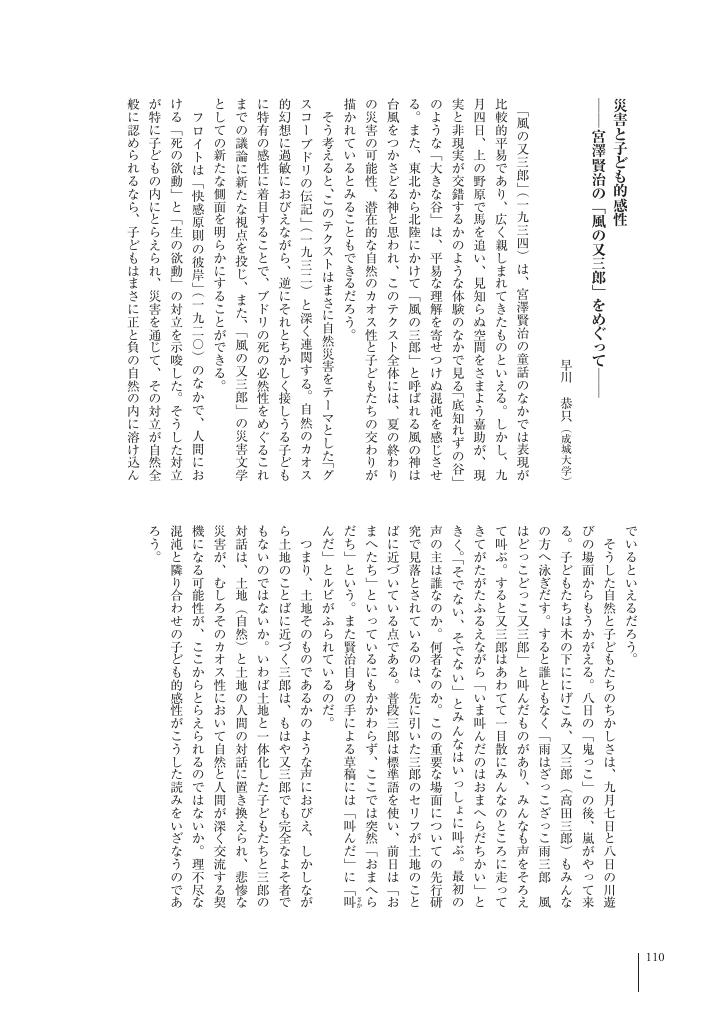10 0 0 0 IR 新海誠の『秒速5センチメートル』における放浪のイメージ (成城学園創立100周年記念号)
- 著者
- 早川 恭只
- 出版者
- 成城大学文芸学部
- 雑誌
- 成城文藝 = The Seijo University Arts and Literature Quarterly (ISSN:02865718)
- 巻号頁・発行日
- no.240, pp.454-434, 2017-06
2 0 0 0 OA 新海誠の『秒速5センチメートル』における放浪のイメージ (成城学園創立100周年記念号)
- 著者
- 早川 恭只
- 出版者
- 成城大学文芸学部
- 雑誌
- 成城文藝 = The Seijo Bungei : the Seijo University arts and literature quarterly (ISSN:02865718)
- 巻号頁・発行日
- no.240, pp.454-434, 2017-06
2 0 0 0 OA 虚構と現実の融解 : アッバス・キアロスタミの『そして人生はつづく』について
- 著者
- 早川 恭只
- 出版者
- 美学会
- 雑誌
- 美学 (ISSN:05200962)
- 巻号頁・発行日
- vol.63, no.2, pp.97-108, 2012-12-31 (Released:2017-05-22)
Many films which take disasters like earthquakes as their subjects are fictional. And life goes on (1992) is a movie about the big 1990 earthquake in Iran. However, fiction and reality are interwoven equivalently by Kiarostami. This truly reflects his own style of making films. The earthquake really hit a place where Kiarostami had shot a previous film, and And life goes on is just a fiction based on reality, in which a cineaste who is an actor travels with his son to ask the safety of previous cast members. This film can pretend to be a documentary, but includes the exposure of being fiction, and its fictional images are contrasted by the views of the devastated area and victims' narration. However, the local children seem to play what they should be beyond themselves and their roles in the film. In such their self-direction, we can recognize a truth about children who have got not only a victims' desire to continue living and their daily lives but also the film makers' desire to expect such a situation. The evidence of a child's life can be brought to such interstice between fiction and reality, where the difference between them melts and fuses.
- 著者
- 早川 恭只
- 出版者
- 美学会
- 雑誌
- 美學 (ISSN:05200962)
- 巻号頁・発行日
- vol.62, no.2, 2011-12-31
1 0 0 0 OA 災害と子ども的感性 宮澤賢治の「風の又三郎」をめぐって
- 著者
- 早川 恭只
- 出版者
- 美学会
- 雑誌
- 美学 (ISSN:05200962)
- 巻号頁・発行日
- vol.69, no.2, pp.110, 2018 (Released:2020-03-23)
- 著者
- 早川 恭只
- 出版者
- 美学会
- 雑誌
- 美学 (ISSN:05200962)
- 巻号頁・発行日
- vol.62, no.2, pp.148, 2011-12-31 (Released:2017-05-22)
1 0 0 0 OA 虚構と現実の融解 : アッバス・キアロスタミの『そして人生はつづく』について
- 著者
- 早川 恭只
- 出版者
- 美学会
- 雑誌
- 美學 (ISSN:05200962)
- 巻号頁・発行日
- vol.63, no.2, pp.97-108, 2012-12-31
Many films which take disasters like earthquakes as their subjects are fictional. And life goes on (1992) is a movie about the big 1990 earthquake in Iran. However, fiction and reality are interwoven equivalently by Kiarostami. This truly reflects his own style of making films. The earthquake really hit a place where Kiarostami had shot a previous film, and And life goes on is just a fiction based on reality, in which a cineaste who is an actor travels with his son to ask the safety of previous cast members. This film can pretend to be a documentary, but includes the exposure of being fiction, and its fictional images are contrasted by the views of the devastated area and victims' narration. However, the local children seem to play what they should be beyond themselves and their roles in the film. In such their self-direction, we can recognize a truth about children who have got not only a victims' desire to continue living and their daily lives but also the film makers' desire to expect such a situation. The evidence of a child's life can be brought to such interstice between fiction and reality, where the difference between them melts and fuses.



